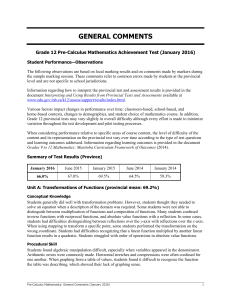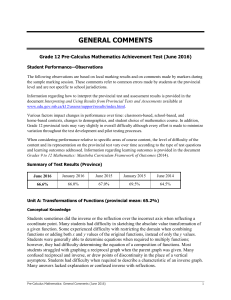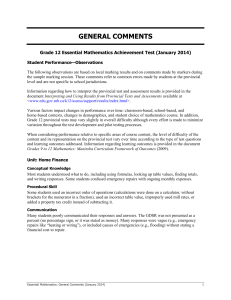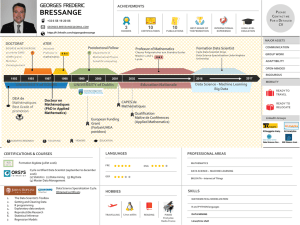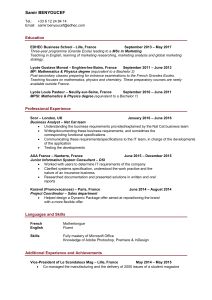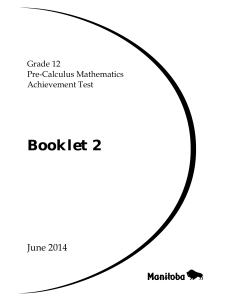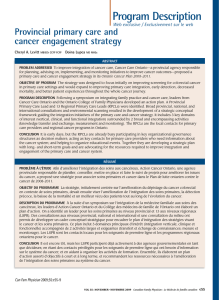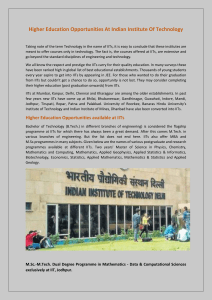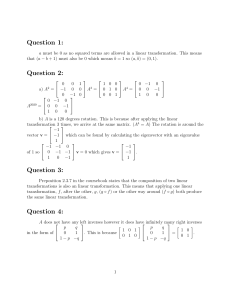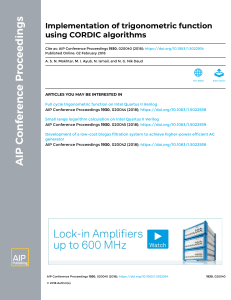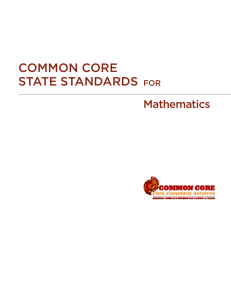43 KB
publicité
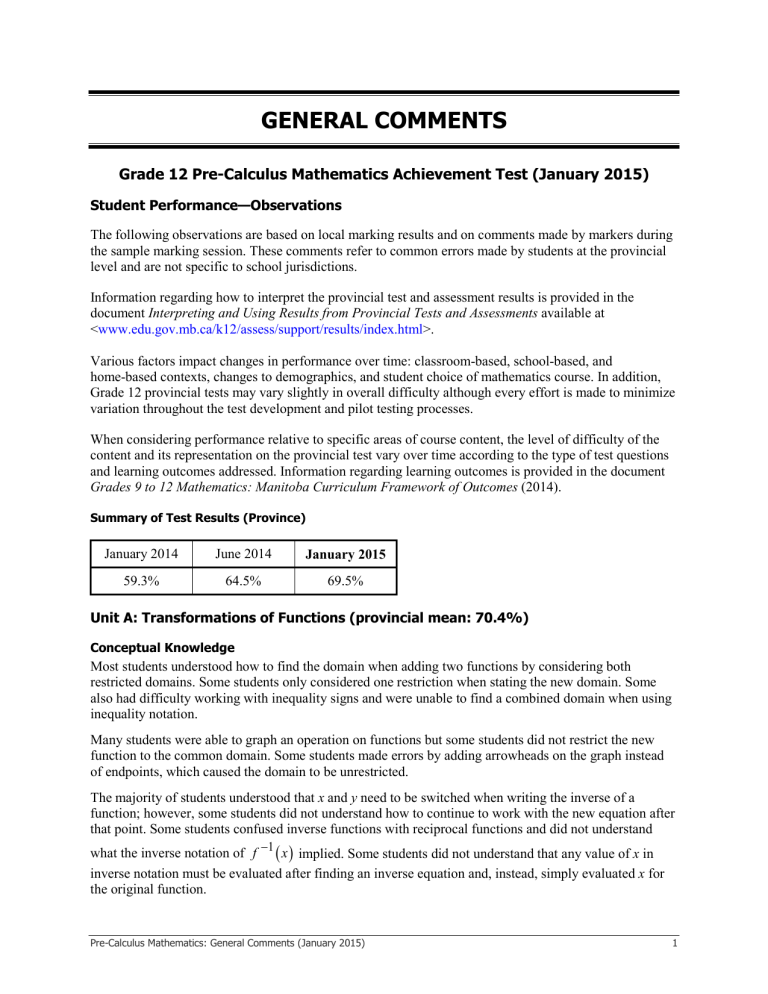
GENERAL COMMENTS Grade 12 Pre-Calculus Mathematics Achievement Test (January 2015) Student Performance—Observations The following observations are based on local marking results and on comments made by markers during the sample marking session. These comments refer to common errors made by students at the provincial level and are not specific to school jurisdictions. Information regarding how to interpret the provincial test and assessment results is provided in the document Interpreting and Using Results from Provincial Tests and Assessments available at <www.edu.gov.mb.ca/k12/assess/support/results/index.html>. Various factors impact changes in performance over time: classroom-based, school-based, and home-based contexts, changes to demographics, and student choice of mathematics course. In addition, Grade 12 provincial tests may vary slightly in overall difficulty although every effort is made to minimize variation throughout the test development and pilot testing processes. When considering performance relative to specific areas of course content, the level of difficulty of the content and its representation on the provincial test vary over time according to the type of test questions and learning outcomes addressed. Information regarding learning outcomes is provided in the document Grades 9 to 12 Mathematics: Manitoba Curriculum Framework of Outcomes (2014). Summary of Test Results (Province) January 2014 June 2014 January 2015 59.3% 64.5% 69.5% Unit A: Transformations of Functions (provincial mean: 70.4%) Conceptual Knowledge Most students understood how to find the domain when adding two functions by considering both restricted domains. Some students only considered one restriction when stating the new domain. Some also had difficulty working with inequality signs and were unable to find a combined domain when using inequality notation. Many students were able to graph an operation on functions but some students did not restrict the new function to the common domain. Some students made errors by adding arrowheads on the graph instead of endpoints, which caused the domain to be unrestricted. The majority of students understood that x and y need to be switched when writing the inverse of a function; however, some students did not understand how to continue to work with the new equation after that point. Some students confused inverse functions with reciprocal functions and did not understand −1 what the inverse notation of f ( x ) implied. Some students did not understand that any value of x in inverse notation must be evaluated after finding an inverse equation and, instead, simply evaluated x for the original function. Pre-Calculus Mathematics: General Comments (January 2015) 1 When given a point on the graph of a function after a series of transformations, many students were unable to recognize how to find a point on the original function, f ( x ) . Many students did not realize that this concept requires them to work backwards and, instead, substituted the transformed point back into the transformed function. Most students were able to correctly apply transformations to a graph. Those who committed errors tended to confuse horizontal compressions with vertical compressions or horizontal compressions with horizontal stretches. Also, some students did not apply compressions at all and confused compressions with horizontal shifts. Many students understood how to find the composition of two functions in order to evaluate a value of x; however, some students struggled when one of the functions was an absolute value function and were unable to apply the absolute value correctly. Procedural Skill Some students used tables of values to perform transformations on functions. This assisted in mapping points but led to unusual shapes as students made arithmetic errors or transcription errors. When isolating y to determine an equation for an inverse function, some students made arithmetic errors that led to incorrect inverse functions. Communication Many students were able to find a new equation for the inverse of a function but did not state their final −1 answer using proper inverse notation, f ( x ) . Similarly, when finding a composition of functions, many students had incorrect function notation and/or did not state their final answer using the proper notation. Students generally knew proper techniques for graphing, with the most common error being failure to provide arrowheads or endpoints. Students also frequently drew incorrect shapes for graphs either by confusing the function with a different type of function or by failing to draw it in the right location using points that should appear on the graph. Unit B: Trigonometric functions (provincial mean: 71.2%) Conceptual Knowledge Students were generally successful when converting from degrees to radians, though they sometimes did not understand when to use radians or degrees. Many thought that arc length is measured in radians. When solving trigonometric equations, some students did not realize they could substitute in trigonometric identities to make equations solvable using quadratic methods. When solving for the period, 2π most students were able to recognize they needed to use the formula , but were unable to identify [b ] what the value of b was. Sometimes students did not take the reciprocal values of sin θ , cos θ , and tan θ when substituting values of csc θ , sec θ , and cot θ . Procedural Skill Some students found providing answers within a specific domain difficult. When solving for arc length, students used the diameter instead of the required radius measurement in the formula. Students found factoring quadratic trigonometric equations difficult. They also found it difficult to determine which identity to use. Dividing by fractions proved most difficult for some students. When graphing trigonometric functions, it was difficult for students to apply the correct period to the graph. Students 2 Pre-Calculus Mathematics: General Comments (January 2015) sometimes had difficulties in identifying the correct trigonometric ratios for specific angle measures and the quadrants they were in. Communication Students demonstrated transcription errors, especially with negative signs. Students often forgot to use units, and scales were often missed on axes when graphing trigonometric functions. Some students made notation errors when using trigonometric functions without including the variable θ . Other common errors included exchanging variables like θ and x, confusing squared trigonometric values with double angle values, and changing equations to expressions. Unit C: Binomial Theorem (provincial mean: 77.7%) Conceptual Knowledge When solving questions related to binomial theorem expansion, most students were able to substitute correctly into the given formula, but some students were unable to identify the correct term for which they were to solve. Most students were able to correctly substitute into the permutation and combination formula, but some had trouble identifying from a word problem when to use permutations and when to use combinations. When solving a fundamental counting principle question, some students added instead of multiplying while some incorrectly wrote it with factorials. Procedural Skill When solving questions related to binomial theorem expansion, some students forgot to include negative signs for terms from the question into the formula. Some students made algebraic errors or made mistakes with their exponent laws when trying to simplify their answers. Some students did not realize they had to fully simplify the answer after substituting into the formula. When expanding factorials, even though students were able to correctly substitute into the formula, many struggled with the simplification process when they had to simplify a fraction divided by a fraction and made many arithmetic errors in the process. Communication Students presented their work well and had very few communication errors in this unit. Even though students were able to set up their work correctly, some did not state their final answer at the end with simple permutation and fundamental counting principle questions. When expanding factorials, some students had notational errors such as forgetting to include the factorial sign, or misplacing it inside a bracket when expanding factorials. Unit D: Polynomial Functions (provincial mean: 82.0%) Conceptual Knowledge Students did quite well on this unit. Most students were able to graph a polynomial function. Many students were also able to use the strategy of synthetic division. Some students mixed up multiplicity with end behaviour and others were confused about the end behaviour of odd and even functions. Procedural skill Students were successful in following the procedures for the factor theorem or synthetic division. Some students stated their answers as factors instead of as zeroes. Another error was the failure to recognize a negative coefficient (the “a” value in their polynomial function), impacting the end behaviour of an odd function. Pre-Calculus Mathematics: General Comments (January 2015) 3 Communication A common error in this unit was writing the result of synthetic division as an expression. There were some minor arithmetic errors and a few transcription errors. In graphing polynomials, some students missed arrowheads on their graphs while other students incorrectly curved the end of their polynomial graphs (making it appear like a sinusoidal graph). When responding to ‘explain’ or ‘justify’ questions, students sometimes gave incomplete responses where only one situation was considered. For example a student would explain the end behaviour of an even graph, but make no mention of what an odd graph would look like. Other responses from students lacked complete and accurate justification. Unit E: Trigonometric Equations and Identities (provincial mean: 57.9%) Conceptual Knowledge Many students struggled with an error analysis question (identify and explain an error in a provided response). While some students thought that secant and sine were reciprocal functions, most students knew that cosine is the correct reciprocal function. They did not know that the range of sec θ is greater than or equal to 1 or less than or equal to −1 , and that sine and cosine values must be between −1 and 1 . When solving trigonometric equations, students often only identified the reference angle, and forgot to solve for the second angle. Students knew their unit circle values well, and were proficient at substituting identities, especially on the proof. There was some confusion with a double angle, and most students treated the concept of ‘verifying’ as a ‘proof’, rather than verifying with the given value as instructed. Procedural Skill While students knew substitution of identities on the proof (identity) question, they were not able to use the necessary algebraic strategies to complete the proof. Finding common denominators, simplifying complex fractions, and cancelling common factors were difficult for students. When given sin α or cos β , students used the Pythagorean theorem to solve for cos α and sin β incorrectly. They often set up the triangles incorrectly or in incorrect quadrants. Arithmetic errors were also common within the trigonometric questions. While the students knew their unit circle values well, using these fractional values within a verifying question or some other trigonometric questions that required various arithmetic operations to be performed with fractions proved to be very difficult for most students. Communication The most common errors were the missing variables (i.e., writing sine, cosine, or tangent without a variable following it). Some students also failed to consider the domain, expressing answers in degrees rather than radians, and vice versa. Many students also did not state their answers to at least three decimal places (one decimal place was very common). Unit F: Exponents and Logarithms (provincial mean: 70.0%) Conceptual Knowledge When asked to use laws of logarithms, students generally did a good job with the product, quotient, and power laws. However, many students had trouble working with the “e” value in the logarithmic word problem. When evaluating the logarithmic equation, students had trouble finding the final answer without a calculator, but when estimating logarithms, students were able to use benchmarks to understand larger or smaller logarithmic values. Some students were able to solve a logarithmic equation but did not reject the extraneous root. Most students were able to sketch the graph of a decreasing exponential function. Overall, students understood how to identify and begin to solve an exponential or logarithmic question. 4 Pre-Calculus Mathematics: General Comments (January 2015) Procedural Skill When solving logarithms, students understood how to equate bases and how to put a logarithmic equation into exponential form. Once in exponential form; however, students had trouble evaluating the exponential form to find a final answer. They were able to apply the laws of logarithms but used incorrect order of operations when working towards their final answer. Many students did not simplify the growth formula before taking the natural log of each side of the formula. Students were able to use benchmarks when estimating logarithms. When graphing an exponential function, students did not indicate the horizontal asymptote. Communication Communication errors were minimal. Students made some rounding errors and some did not round to 3 decimal places. Students changed equations to expressions, and there were some bracket errors that were still implied with their mathematical reasoning. When graphing an exponential function, some students correctly drew the graph with correct asymptotic behaviour but failed to include the horizontal asymptote as well as label their x and y axes. Overall, the communication for this unit was well done. Unit G: Radicals and Rationals (provincial mean: 71.3%) Conceptual Knowledge When asked to sketch the radical graph of a given function, students had difficulty restricting the domain properly. Students frequently mixed up vertical and horizontal reflections when sketching the graph of a given radical function while only a few students mixed up horizontal and vertical transformations. Some students used a table of values to graph, showing no knowledge of graphing using transformations. When identifying the point of discontinuity (hole) of a rational graph, many students only gave the x-coordinate. A few students incorrectly stated that there was no point of discontinuity (hole). When graphing a rational function, some students did not sketch a horizontal asymptote while others sketched the vertical asymptote incorrectly. Procedural Skill When sketching the graph of a given radical function, some students knew there were invariant points but plotted them incorrectly. Other students did not show the invariant points clearly but their graph went through them. There were frequent arithmetic errors when determining the y-coordinate of the point of discontinuity. Other students substituted the x-coordinate into the wrong function and found an incorrect y-coordinate. Communication When stating a point of discontinuity, some students stated that x could not equal a value rather than stating that x was equal to it. Many students did not show two points on a graph as outlined on the terminology sheet. Students did not label their axes with a scale on their graph of a rational function and did not indicate a scale through labeling points and/or asymptotes. Some students knew the graph should approach the asymptote but did not show proper asymptotic behaviour when their graphs crossed or curled away from the asymptote. Pre-Calculus Mathematics: General Comments (January 2015) 5 Communication Errors Errors that are not related to the concepts within a question are called “Communication Errors” and these were indicated on the Answer/Scoring Sheet in a separate section. There was a maximum ½ mark deduction for each type of communication error committed, regardless of the number of errors committed for a certain type (i.e., committing a second error for any type did not further affect a student’s mark). The following table indicates the percentage of students who had at least one error for each type. 6 E1 § § answer given as a complex fraction final answer not stated 15.3% E2 § § changing an equation to an expression equating the two sides when proving an identity 35.7% E3 § § variable omitted in an equation or identity variables introduced without being defined 12.6% E4 § § “ sin x ” written instead of “ sin x ” missing brackets but still implied 5.3% E5 § § § missing units of measure incorrect units of measure answer stated in degrees instead of radians or vice versa 22.8% E6 § § rounding error rounding too early 32.0% E7 § § notation error transcription error 43.5% E8 § § § answer included outside the given domain bracket error made when stating domain or range domain or range written in incorrect order 7.4% E9 § § § incorrect or missing endpoints or arrowheads scale values on axes not indicated coordinate points labelled incorrectly 35.9% E10 § § § asymptotes drawn as solid lines asymptotes missing but still implied graph crosses or curls away from asymptotes 5.3% 2 2 Pre-Calculus Mathematics: General Comments (January 2015) Marking Accuracy and Consistency Information regarding how to interpret the marking accuracy and consistency reports is provided in the document Interpreting and Using Results from Provincial Tests and Assessments available at <www.edu.gov.mb.ca/k12/assess/support/results/index.html>. These reports include a chart comparing the local marking results to the results from the departmental re-marking of sample test booklets. Provincially, 33.1% of the test booklets sampled resulted in a higher score locally than those given at the department; in 10.7% of the cases, local marking resulted in a lower score. Overall, the accuracy of local versus central marking for the test was consistent. To highlight this consistency, 56.2% of the booklets sampled and marked by the department received a central mark within ± 2% of the local mark and 95.3% of the sampled booklets were within ± 6% . Scores awarded at the local level were, on average, 0.4% higher than the scores given at the department. Survey Results Teachers who supervised the Grade 12 Pre-Calculus Mathematics Achievement Test in January 2015 were invited to provide comments regarding the test and its administration. A total of 115 teachers responded to the survey. A summary of their comments is provided below. After adjusting for non-responses: • 92.0% of the teachers indicated that all of the topics in the test were taught by the time the test was written. • 100% of the teachers indicated that the test content was consistent with the learning outcomes as outlined in the curriculum document. 100% of teachers indicated that the reading level of the test was appropriate and 99.2% of them thought the test questions were clear. • 96.3% and 94.2% of the teachers, respectively, indicated that students were able to complete the questions requiring a calculator and the entire test in the allotted time. • 95.6% of the teachers indicated that their students used a formula sheet throughout the semester and 100% of teachers indicated that their students used the formula sheet during the test. • 49.1% of the teachers indicated that graphing calculators were incorporated during the instruction of the course and 97.2% of teachers indicated that the use of a scientific calculator was sufficient for the test. Pre-Calculus Mathematics: General Comments (January 2015) 7
